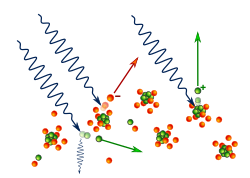Low Energy
The photoelectric effect is the emission of electrons when electromagnetic radiation, such as light, hits a material. Electrons emitted in this manner are called photoelectrons. The phenomenon is studied in condensed matter physics, and solid state and quantum chemistry to draw inferences about the properties of atoms, molecules and solids. The effect has found use in electronic devices specialized for light detection and precisely timed electron emission.
The experimental results disagree with classical electromagnetism, which predicts that continuous light waves transfer energy to electrons, which would then be emitted when they accumulate enough energy. An alteration in the intensity of light would theoretically change the kinetic energy of the emitted electrons, with sufficiently dim light resulting in a delayed emission. The experimental results instead show that electrons are dislodged only when the light exceeds a certain frequency—regardless of the light's intensity or duration of exposure. Because a low-frequency beam at a high intensity could not build up the energy required to produce photoelectrons, as it would have if light's energy were coming from a continuous wave, Albert Einsteinproposed that a beam of light is not a wave propagating through space, but a swarm of discrete energy packets, known as photons.
Emission of conduction electrons from typical metals requires a few electron-volt (eV) light quanta, corresponding to short-wavelength visible or ultraviolet light. In extreme cases, emissions are induced with photons approaching zero energy, like in systems with negative electron affinity and the emission from excited states, or a few hundred keV photons for core electrons in elements with a high atomic number.[1] Study of the photoelectric effect led to important steps in understanding the quantum nature of light and electrons and influenced the formation of the concept of wave–particle duality.[2] Other phenomena where light affects the movement of electric charges include the photoconductive effect, the photovoltaic effect, and the photoelectrochemical effect.
https://en.wikipedia.org/wiki/Photoelectric_effect
Mid Energy
Thomson scattering is the elastic scattering of electromagnetic radiation by a free charged particle, as described by classical electromagnetism. It is the low-energy limit of Compton scattering: the particle's kinetic energy and photon frequency do not change as a result of the scattering.[1] This limit is valid as long as the photon energyis much smaller than the mass energy of the particle: , or equivalently, if the wavelength of the light is much greater than the Compton wavelength of the particle (e.g., for electrons, longer wavelengths than hard x-rays).
https://en.wikipedia.org/wiki/Thomson_scattering
High Energy
Pair production is the creation of a subatomic particle and its antiparticle from a neutral boson. Examples include creating an electron and a positron, a muon and an antimuon, or a proton and an antiproton. Pair production often refers specifically to a photon creating an electron–positron pair near a nucleus. As energy must be conserved, for pair production to occur, the incoming energy of the photon must be above a threshold of at least the total rest mass energy of the two particles created. (As the electron is the lightest, hence, lowest mass/energy, elementary particle, it requires the least energetic photons of all possible pair-production processes.) Conservation of energy and momentum are the principal constraints on the process.[1]All other conserved quantum numbers (angular momentum, electric charge, lepton number) of the produced particles must sum to zero – thus the created particles shall have opposite values of each other. For instance, if one particle has electric charge of +1 the other must have electric charge of −1, or if one particle has strangeness of +1 then another one must have strangeness of −1.
The probability of pair production in photon–matter interactions increases with photon energy and also increases approximately as the square of atomic number of (hence, number of protons in) the nearby atom.[2]
https://en.wikipedia.org/wiki/Pair_production
| Light–matter interaction |
|---|
 |
| Low-energy phenomena: |
| Photoelectric effect |
| Mid-energy phenomena: |
| Thomson scattering |
| Compton scattering |
| High-energy phenomena: |
| Pair production |
| Photodisintegration |
| Photofission |
Tool - pneuma, right in two, the pot, fourty six and two, lateralus, schism
Deftones - passanger, change

No comments:
Post a Comment